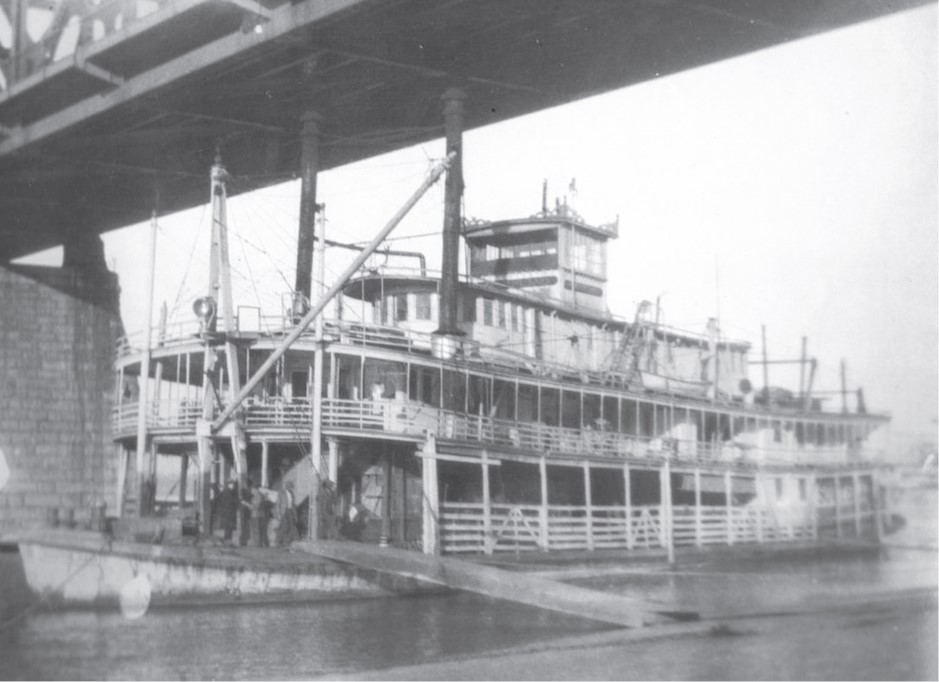In 1910, the Howard Shipyards at Jeffersonville built a trim sternwheeler named Nashville to run in the Evansville–Nashville–Paducah trade for W.W. Parminter of Nashville, Tenn.
The wood-hulled riverboat measured 155 feet in length by 34 feet in width and had compound engines, manufactured by Gillett & Eaton, containing cylinders of 14 and 22 inches with a 5-foot stroke. Capt. Shep Green was master and Harry Sayre, clerk.
Due to high labor costs and the scarcity of coal, the boat was retired in 1918. At a public sale held on December 21, 1918, the vessel was purchased by the Nashville Trust Bank. In April 1919, the Williams Brothers of Evansville bought it to run in the Louisville–Stephensport–Evansville trade, rebuilding the boat in 1922 at Paducah and renaming it Southland. The boat ran between Louisville and Henderson, Ky., and was a favorite of many river people in the region.
One who fell under the spell of the steamboat was C.W. Stoll (1916–2001) who for many years was the Louisville correspondent for The Waterways Journal, beginning when he was 15 years old. He always referred to the Southland as his “first love” steamboat, making frequent trips and doing his cub piloting under Capt. Lawrence “Bo” Allen and Capt. Jimmy Ostrander. C.W. said that when the sorrowful news came of the Southland’s demise, just several days before Christmas, he felt as if his world had come to an end.
In the forward part of the texas deck was a large observation room for passengers to observe the passing scenery. The boat generally made one round trip per week, laying over at Louisville for several days. Passengers and freight, as well as livestock, were carried in typical packet boat fashion.
When my paternal grandmother’s family moved in 1927 from Meade County, Ky., to New Albany, Ind., the trip was made up the Ohio aboard the Southland. My grandmother recalled that their worldly possessions were loaded onto the boat at Brandenburg, Ky., and when being offloaded at New Albany the cast iron cook stove was dropped by roustabouts on the cobblestone wharf, breaking one leg off and making my great-grandmother most unhappy!
The Southland was distinguished by its thin smokestacks and an unusual whistle, reputed to have come from an Italan freighter. Capt. Fred Way described the whistle as not being large but yielding a high soprano tone which “needed to be cultivated as a taste, much like eating oysters!” Legend has it that in 1862 a sidewheel packet named Eugene was tied up near the ship at a New Orleans wharf and that the crew “liberated” the much-admired whistle. Once out of earshot of the Louisiana port, they installed it on the Eugene. Their enjoyment was short-lived, for the boat struck a snag at Osceola, Ark., on November 14 of that year and sank. After the aforementioned and brief tenure on the Eugene, the salvaged whistle eventually found its way to Evansville, Ind., and its next home on the sternwheeler Hettie Gilmore. Shortly thereafter, it was installed on the new sidewheel steamer Tarascon, built at Howard’s in 1863.
Some time after the fall of Vicksburg, the Tarascon made a trip to New Orleans, where the crew of an Italian freighter heard a whistle very familiar to their ears. They demanded the whistle’s return and immediately filed suit to retrieve their stolen property. The French consul heard the case, several times, and ultimately ruled that the Tarascon had legally acquired the whistle from an abandoned wreck (the Eugene) and hence was exonerated of any guilt. The whistle remained on the Tarascon until 1877, following which it served on the steamboats James Guthrie, Tell City, and the Nashville, which became the Southland.
The Lower Ohio River trade that the Southland plied for many years was badly affected by the Great Depression, and the boat was laid up at Spottsville, Ky., on the Green River. On December 16, 1932, the venerable boat, along with three towboats, was totally destroyed in a spectacular fire, taking the infamous whistle with it for eternity.




